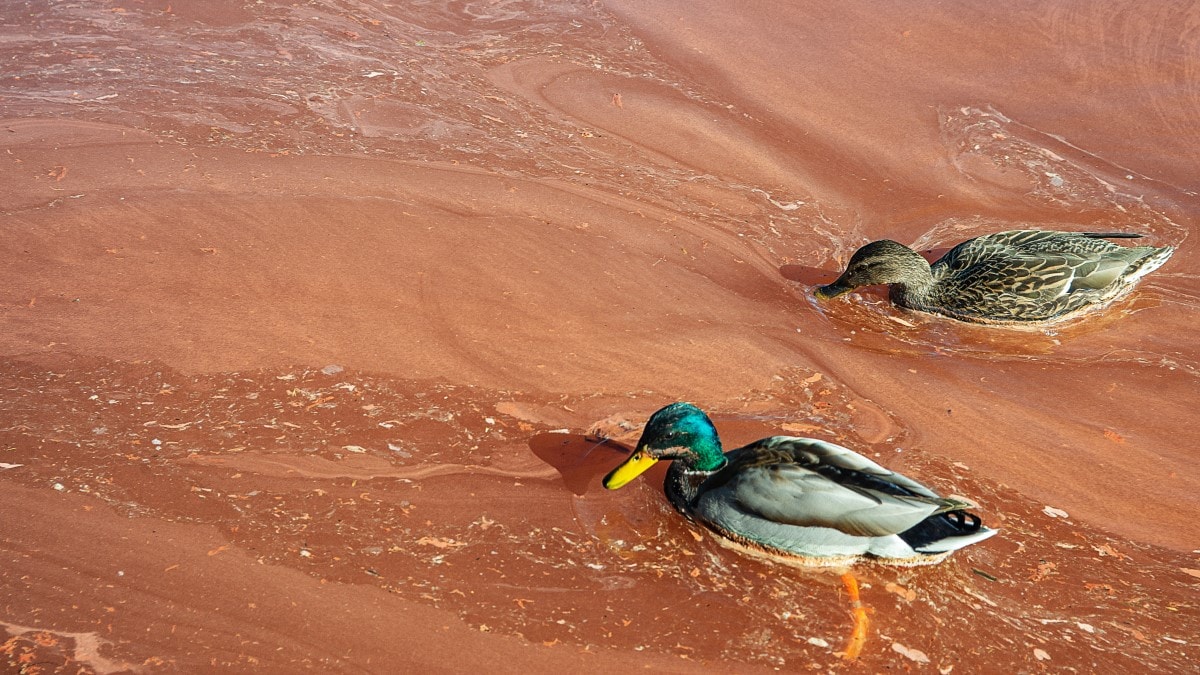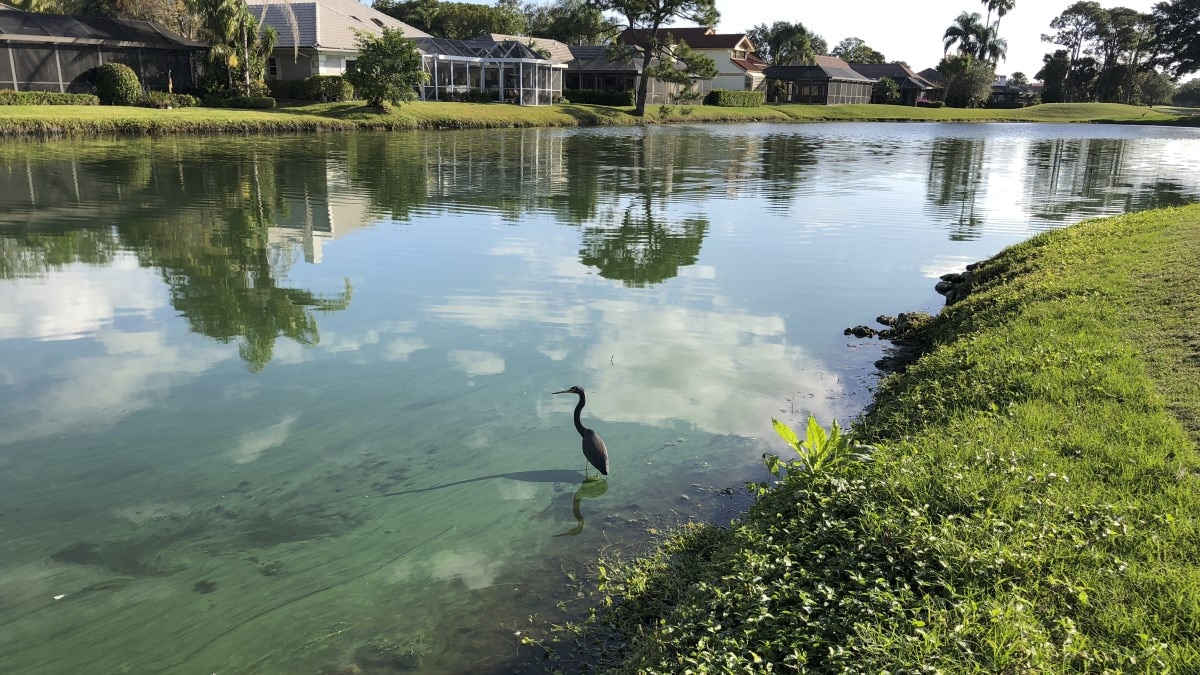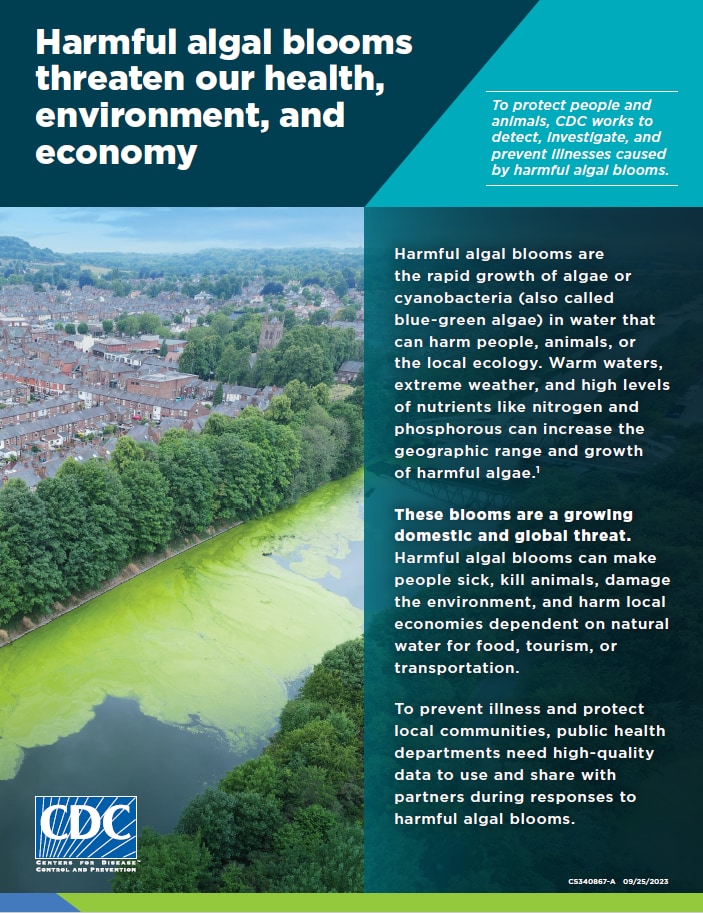Key points
- Harmful algal blooms can hurt local ecosystems, including people, animals, and plants.
- Harmful algal blooms are more likely to grow in warm, slow-moving water with many nutrients.
- Help prevent harmful algal blooms from growing by using fertilizers properly and maintaining your septic system.

Overview
Algae are an important part of ecosystems in fresh waters, salt waters, and brackish (a mix of fresh and salt) waters.
However, under the right conditions some types of algae can be harmful when they grow too quickly or make toxins.
Terms to know
Ecosystems are made up of living things and their physical environment. People, animals, plants, and local environments are all part of an ecosystem.
Contributing factors
Many factors can help harmful algal blooms grow:
High nutrient levels
Too many nutrients, such as nitrogen and phosphorus, in water help harmful algal blooms grow.
Nutrient pollution in water can come from:
- Fertilizer (used on farms and home lawns, for example)
- Sewage or poop from people and animals
- Run-off from cities and industrial buildings (during rainstorms, for example)
Deep ocean water rising towards the surface also increases nutrient levels. This rising of water is called upwelling. It can happen along the western U.S. coast when there are changes in temperature between the ocean and the air above the eastern Pacific Ocean.
Warm water
Harmful algal blooms are more likely to grow in warm water. Blooms happen more often in summer or fall but can occur any time of year.
Slow-moving water
Harmful algal blooms are more likely when water levels are low and water is moving slowly, such as during a drought.
Changing conditions
Changes in water conditions like pH or turbidity (how much "stuff" is floating in the water) can impact the growth of harmful algal blooms. For example, when turbidity is low, light can shine through the water easily. This helps algal blooms grow.
Changes in the local ecology can also impact the growth of harmful algal blooms. Ecology is how living things interact with the environment and with each other.
Climate change
Climate change can increase the growth of harmful algal blooms in fresh, salt, and brackish water. It can make blooms occur more often and be more severe. For example, warming temperatures in Lake Erie have contributed to large harmful algal blooms of cyanobacteria (blue-green algae) that last into the early winter months. In recent years, such blooms have been found more often and in more places across the United States.
Researchers are still learning how climate change is affecting harmful algal blooms and how different parts of the country are impacted.
Learn more about climate change and harmful algal blooms on the U.S. Environmental Protection Agency's (EPA) website and the National Oceanic and Atmospheric Administration's (NOAA) website.

Ecosystem impacts
Algal blooms can harm people, animals, or the environment when they:
- Make toxins (poisons)
- Become too dense
- Use up the oxygen in the water
- Release harmful gases
Toxins
Producing toxins is the main way harmful algal blooms make people and animals sick. Toxins can be in the cells of the algae or released into the water.
People and animals get sick when they come into contact with toxins through water or food.
Dense blooms
Sometimes algal blooms become so dense that sunlight cannot go through them. This blocks other plants and animals in the water from getting the sunlight they need to survive. Dense blooms can also clog the gills of fish, shellfish, and other animals, preventing them from breathing.
Decaying blooms
When a bloom dies off, the decay process may use up all the oxygen in the water. Without oxygen, other living things in the water suffocate (are not able to breathe). As a bloom decays, it may also release gases that can harm people. These gases include methane and hydrogen sulfide, which smells like rotten eggs.
What you can do
You can help prevent harmful algal blooms from growing by limiting nutrient pollution in water. Even if you do not live right next to a body of water, the nutrients from your home and yard can make their way into nearby lakes, rivers, and oceans. For example, extra fertilizer on your lawn can wash off during rainstorms and run downhill into a nearby stream.
Reduce the amount of nutrients that get into water by:
- Using only the recommended amount of fertilizer (check your product's instructions)
- Maintaining your septic system
Resources
- Climate Change and Freshwater Harmful Algal Blooms | U.S. EPA
- Harmful Algal Blooms | NOAA's NCCOS Coastal Science Website
- Research on Harmful Algal Blooms | U.S. Geological Survey
- Nutrient Pollution | U.S. EPA
- About One Health

